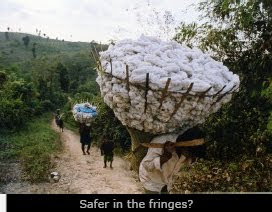

 Single mothers also qualify for man capture
Single mothers also qualify for man captureTo capture a man, then immediately marry him, you need a chicken.
When the cotton is in bloom, it is the season for man capture. Men from one village capture men from another for marriage to their unmarried sisters, cousins and nieces. If a man accepts the marriage, he moves into the village of his wife and shares her property. And if he doesn't?
Producers synopsis
In






Screening was done amongst the Bachelor of education Students of St Xavier's College. Their responses were of diverse variety ...
- The gender roles amongst the tribal society are very difficult to understand. They vary so much according to tribes. In mainstream communities it is typically patrilineal and has ingredients of patriarchy and the tribal communities which are coming in close contact are also witnessing a change towards these characteristics.
- The custom of capture is bad...it is against the will of an individual. Even marriages by capture of tribal girls from the local market and forcible putting of sindur in the forehead, prevalent in many tribes of peninsular belt are being done away with.
- As educators one should keep in mind that the modern day education is also laden with values of the mainstream society. These need to be modified to suit/ give space to their cultural contexts. The overburdening of ‘our’ values to ‘them’ should be avoided.
- Any cultural practices which violate the human rights of an individual should be modified / rectified. This should be through proper dialogue otherwise the implementation of the ‘reform processes’ will not see its success.
- The beauty of the tribal community depicted is immense. Although the girl is not married and has children, the children are getting a space / acceptance in the community. Even the unmarried girl is not ‘in guilt’, and she is able to live her life.
- But still the questions are how long this acceptance from the community remains. What are the rights of the children with regard to property?
- The concept of marriage has a variety. There are number of forms in which one can marry. The live-in relationship converting into marriage is also one of the forms that have been prevalent for a long time in some of the tribes (it is a new phenomenon in mainstream communities).
- But the rights of individuals engaging in such informal relationships are still ‘not yet defined’. And there are quite many situations when such human rights issues do come up... Isn’t there a need to move towards formal marriages where there are more formal ways of coming together and also of separation, and the rights in such situations are more defined?
- Anthropological reflections as given in the documentary are very difficult to document unless you are accepted as an insider. The filmmaker stayed / visited there for quite some years before she could complete the film.
- Earlier such documentation was very difficult as the communication mediums had not developed and hand writing was the only option. Great work still was done and many books have been written by such anthropologists which are very valuable in documenting there customary practices. Now the digital tools help in making this documentation easier. But and insider / outsider, we / them... positions in such documentation still remains big challenge.





